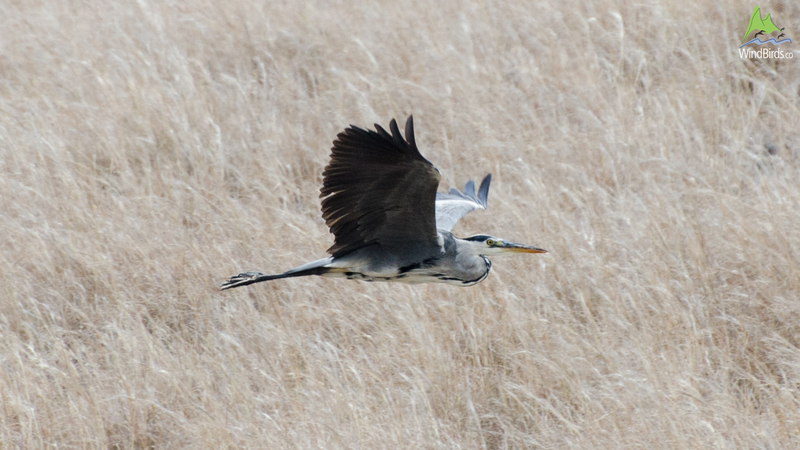Grey Heron Ardea cinerea Linnaeus, 1758
Order: Pelecaniformes Family: Ardeidae Status: Vagrant to Madeira

Ardea cinerea Biometrics
Wingspan: 160 - 175 cm (Beaman & Madge, 2011)
Total length: 90 - 98 cm (Beaman & Madge, 2011)
Weight: 1.6 - 2 kg (Hume, 2002)
Recommended birdwatching tours to watch this bird
This bird can be seen throughout the year though it is more common between October and March on the following Wind Birds's tours:
Half-day Birdwatching
Full-day Birdwatching
Grey Heron Field ID Keys
Shape & Size
Large heron with long neck and legs and heavy bill.
Colour Pattern
Generally, as the name says, it is a grey bird. Upper-parts are light grey and underparts and neck are white. It has a black cap and when flying their wings are black until mid-wing. Its bill is pinkish at the base and yellow towards the tip. Its legs are pink/grey. Juvenile birds have spotted front, from neck to belly, darker bill and pale grey head.
Behavior
Its a solitary bird but may gather in small flocks for feeding or roosting. When flying its head withdraws and the neck forms kind of a bulge.
Habitat
Frequents wetlands both freshwater and saltwater (Beaman & Madge, 2011) though for roosting it prefers trees.
Distinction from similar species
It is relatively easy to confuse this species with a Purple Heron but this one is generally slimmer and browner, with a brownish/red colour on its neck and underparts while on the Grey Heron they are mostly white some with grey spots.
Other Bird Facts
Seasonality in Madeira: In Madeira it can be observed throughout the year though the bigger numbers of this species occur between October and March.
Breeding: Although it may be seen throughout the year, there are no evidences of breeding in Madeira archipelago. It is a wide spread species in the Eastern West Palearctic. It breeds between January and May with an annual brood of about 4 to 5 eggs (Hume, 2002).
Diet: Catches fish, small amphibians, reptiles, insects and small mammals (Cramp et al., 1977).
Status
Madeira local status by Correia-Fagundes et al, 2021: Frequent
Madeira local status by Romano et al, 2010: Frequent
Madeira local status by Zino et al, 1995: Frequent
Conservation status by the IUCN Red List Categories, 2013: Least Concern ver 3.1
Name of this species in other languages
Portuguese: Garça-real
German: Graureiher-cinerea
Dutch: Blauwe Reiger
Swedish: Gråhäger
Danish: Fiskehejre
Finish: Harmaahaikara
Norwegian: Gråhegre
Spanish: Garza Real
French: Héron cendré
Italian: Airone cenerino
Polish: Czapla siwa
Slovak: Volavka popolavá
Czech: Volavka popelavá